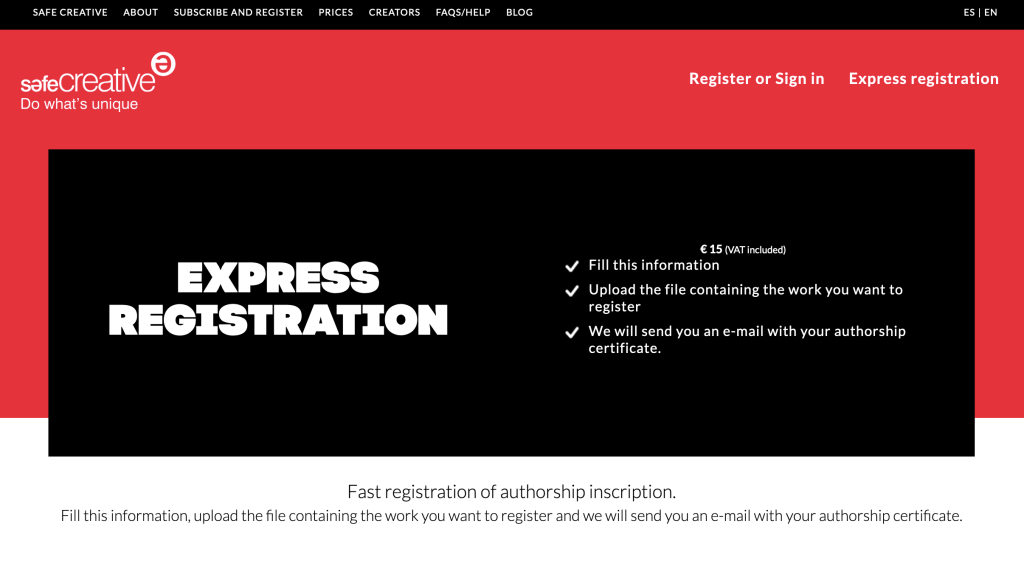
How to make a film sales dossier
You’re a screenwriter, you have an idea and you want to take it to the big screen. It sounds good and it’s viable. And to make it happen you will need a sales dossier which, as its name suggests, is the document that will help you sell your project to a production company or a television network.
On many occasions, whether or not a film will go ahead depends on the sale, so today we give you some tips on how to prepare a film dossier. Are you ready? Lights, camera, action!
What to consider before creating a sales pitch for a film?
As a screenwriter, the first thing you need to do to sell a project is to write the script. Then you’re ready to get the financing, and to do that, you’ll create the sales pitch.
In this article we focus on that second phase: the sale. So if you are still in the first phase, take a look at our post writing a script, where we share a mini-guide with 8 tips.
If you’ve already finished your script, you’ll be eager to start writing your film dossier. Therefore, we have prepared a list of 13 tips + 1 extra that will be very useful. But first let us give you 3 quick recommendations.
1. Think about potential buyers
It seems obvious, but thinking about who your potential buyers are will help you prepare a more appropriate document. Imagine that you are the one who receives that dossier, how would you like it to be? Think of all the doubts that could arise, go ahead and answer them in the document itself. This exercise will help you to deliver a clear document that specifies the necessary details.
2. Take care of the design
The design is another fundamental point. The idea can be very good, but it has to enter through the eyes. A dossier easy to read, clear and with a clean design is much more attractive than a few pages with small print and few paragraphs hooked with a couple of staples. There’s no need for a lot of ornamentation. Most of the time, less is more. But make sure that if a producer has several documents on the table, yours is different and stands out.
To do this, you can hire the services of a layout artist or graphic designer. If this is not possible at the moment, you can choose to design it yourself using a design application with predefined templates to make it easier for you.
3. Register the dossier
Yes, it may seem that we are very insistent on this subject, but it is really important. Registering a script means generating a solid proof of authorship protected by copyright. For this reason, we recommend that you don’t take unnecessary risks and that before showing your work, you register it. This will ensure the enormous creative work behind each project, avoiding possible future problems and, in addition, will help you to give a more professional image.
You can register your sales dossier in Safe Creative from 6,5€ per month.
If you have any doubts about which elements you should register, we recommend you to read our article how to write a film script, where we explain the details and how to make the registration step by step.
After taking into account these 3 recommendations, you are ready to start writing your film dossier.

What should a sales dossier for a film include?
You have already thought about your potential buyers, how you are going to present the document and you have registered it with Safe Creative. Now let’s look at another important aspect: the content. But first we want to make a brief aside.
Normally, the sales dossier of a film follows a similar structure (file, concept, logline, etc.). However, there is no magic formula, nor the perfect dossier, because the final decision will always depend on different factors.
What do we want to tell you with this? That there are as many documents as there are projects and all of them could be correct. However, based on the most successful ones in terms of approval, here is a breakdown of the points that your sales dossier should include.
1. Cover page
A fundamental element to capture attention, so we recommend that it is simple and communicates a clear idea. It should also include:
- Title of the film. It does not have to be the definitive one, but it would be good if it is close.
- Name of the screenwriter or director of the project.
- If it is a feature film, a series or a television program.
- Genre.
- If you want to include a personal brand logo or that of a collaborating entity, you can also do so.
2. File
After the cover page, this is the first thing they will see and it must serve to locate the reader. Here you can define what type of project it is, the locations it will have, the target audience, the original language and the length of the piece. If it is a series, you can also indicate the number of seasons you have planned.
Another information you can add is the casting, only in case it is already closed.
3. Concept
The concept is the form you give to an idea. Describe in a few paragraphs, two or three, the essence of the movie or series. You have to reveal the theme and tell who the main characters are, what their conflict is and where the plot takes place. To make it easier, you can ask yourself the question “what is the movie about?
4. Logline
The logline is the sentence that summarizes the script (the main character and his or her objective). It is written in the third person and should answer 3 basic questions:
- Who is the protagonist?
- What does he or she want to achieve?
- What or who stands in his or her way?
5. Synopsis
The synopsis is the summary of the story and should be about one page long. Here you will explain who the protagonist and main characters are, what events occur and where they take place, as well as the major twists and turns. It would be more like “how I’m going to tell my story” than “what I’m going to tell in my story”.

6. Characters
In this section you have to describe the character of the characters and their function in the story. You should name aspects such as the name, age, profession, personality and conflict of each of them. What are their goals and what conflicts prevent them from achieving them. This could take about half a page for each character.
7. References
What does your project resemble? To help the reader’s imagination, you can use references. For example, mention other movies or series that have inspired you, either because of the subject matter, the narrative or any other element. This section will be much more powerful if you express it with images representative of what you are telling.
8. Plot map
If the plot map is well elaborated, you will hook the reader. Here you must show the main plot and the subplot, how they interact with each other and how they advance. In the case of a television series, draw the plot map by chapters. As a guideline, the explanation of each plot can occupy more or less a paragraph.
9. Aesthetic and artistic treatment
We are moving towards the end of the film dossier, so let’s better outline the project we want to sell. What do you imagine the film would look like? Reveal some aspects of the mise-en-scene, visual style, lighting, photography… To do this, you can use moodboards or include a short audiovisual piece.
If it reinforces the message, you can also add some of the references you mentioned in point number 7.
10. Future seasons
In the case of presenting a sales dossier for a series, you can give more details about the duration of the project. For example, how many more seasons there would be, what they would be about, etc. This gives continuity to the work and helps the reader to visualize the whole project.
11. Filmography and other support
As they say, the die is cast. You have presented the characters, the plots, you have suggested a mise-en-scène… Now you only have to provide arguments that reinforce your proposal, such as your professional background, and that is done in the filmography.
Describe in a few lines your experience and trajectory and reinforce the talent behind the project by mentioning the members of your team. If you have a renowned team, emphasize it. If the project has won an award or received a grant, highlight it.
12. Budget
This is not normally included in the sales dossier, but you could add it depending on who you are presenting it to. For example, if the production company has already joined the project or you have a contact who participates in the decision-making process and has suggested it, you could add it without any problem.

13. Contact information
This is a common mistake, not including contact details. The truth is that if the person who received it is interested, he/she will manage to talk to you, but don’t make it so difficult. Add a final point with contact information. If you can provide two ways, for example, email and telephone, all the better.
And so much for the sales dossier. Including all this information you would already have a more than complete document, but you know that we always like to give you more. So here is a final recommendation.
14. Prepare a pitch
There is a saying that “the more sugar, the sweeter”. So let us tell you how to add that extra sweetness to captivate the team or decision maker: prepare a pitch.
A pitch is a presentation technique widely used in meetings with investors. It is a very brief verbal presentation that the screenwriter makes to the producer in order to capture his or her attention and get financing for the project. This word translates from English as “pitch” and is associated with the concept of “baseball pitcher”, which is called “pitcher”. So we could say that it is an easy and more personal way to prepare the ground to pitch your project.
It is also known as “elevator pitch”, because it is said that the argumentation should last for those seconds that you meet someone in an elevator. Imagine you go up from floor 1 to floor 10 with the person who will make the decision. What would you say? You have to be brief, concise and clear. Introduce yourself and tell them the idea. The other person will want to know more and this way you will awaken their curiosity and make them read your film dossier.
Finally, here are some recommendations to prepare your pitch:
- Introduce yourself.
You can start by saying who you are and what is your role in the project.
- Tell the idea and values of the project.
What is the movie or TV show about? Will it be the first series to be developed on a ship? What will be the highlight? Sell the essence of the project.
- Mention who is behind the project.
Do you have well-known actors? Will you be working with a renowned artistic team? Has the project won any awards? This kind of information always tips the scales in your favor, so you should mention this kind of information.
- Save the title for last.
In this case, the order of the factors does not alter the product. If the other person is interested, you already have their full attention. Now give him a good closing: the title. If he liked it, he will keep the idea and associate it with the written document he will later read.
- Use the right tone.
Do not forget to convey an energetic tone. It must reflect the desire and passion you feel for the project. If you don’t believe in it or are not enthusiastic about it, others won’t be interested in it either.
We hope this information has been very useful and that you can put it into practice. We wish you a lot of success!
